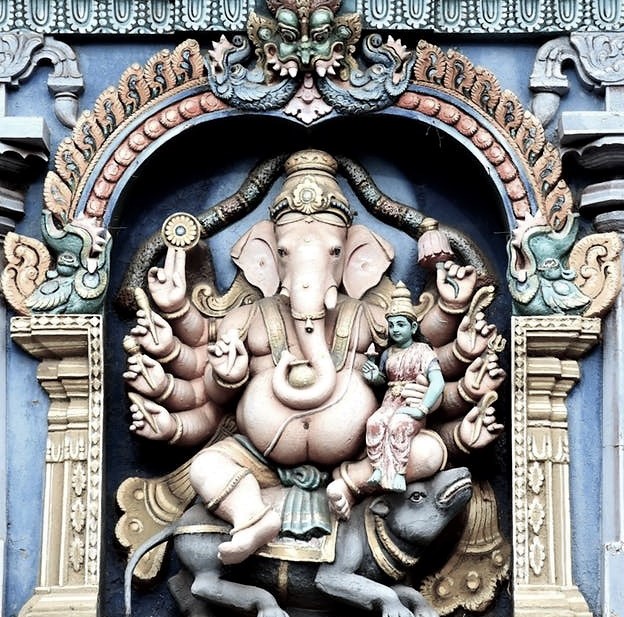- Special FeaturesFoundation Year1000 - 2000 years oldSthala TreeTheerthamHrudapadhaniRathamArchitectureOther Speciality(Divya Desam)
- Sthala Puran
The legend connected with this temple says that one Thai Amavasyai (Jan-Feb New Moon)day, a wandering sage named Salihothran reached Thiruvallur, where he met a congregation sage.
They were engaged in taking a bath in the tank Hrith-Thapa-Nasini, and he was also advised to take a bath before performing his daily rituals. During his bath, Sri Salihotran changed his mind and decided to stay at the bank of that Holy tank and perform penance without food or water for one year.
The next year on the same Pushya Amavasya day, he completed his penance, took a holy dip in the Hrith-Thapa-Nasini tank, and performed his morning prayers. As he was fasting for one year without food and water, he collected some paddy on that day and prepared prasadam using rice flour.
At this juncture, Lord Narayana took the form of an old Brahmin and came the way where Salihotran was waiting to offer a share to a guest. He immediately offered the food to the Brahmin, who ate the offering. Salihotran realized that the old Brahmin was very hungry and immediately offered his share also to the guest. The guest was satisfied after eating and left the place.
Another year of penance continued without any food and drink. Again on the day of Pushya Amavasya, Salihotran took his holy bath and, after his prayers, prepared food as he did the previous year. He offered them food to Sri Narayana and was waiting for a guest.
This time also Lord Narayana took the form of an old Brahmin, and he was welcomed by Salihotran to his hermitage.
The old Brahmin expressed that he was feeling extremely hungry and thirsty and needed a place to rest. After taking prasadam, the old Brahmin expressed to Salihotran, 'where is the place for me to lie down?' (Evvul –in Tamil?) 'In this hermitage,' (I've), answered Salihotran.
The older man was pleased with this offer and stretched his body in the hermitage, placing his head facing south. Immediately, the old Brahmin transformed into the form of Sri Narayana, and Adisesha appeared with his thousand hoods to serve as couch and canopy.
At the request of Salihotra Maharishi, the Lord promised that he would permanently stay there and that he would bless and relieve the diseases and miseries of anyone who prayed to him after taking a bath in the tank. Hence, He is called Sri Vaidhya Veeraraghava Swamy.
In the Puranas, this city is referred to as ‘Veekshaaranya Kshetram.’ As the Lord Sriman Narayana visited the hut of Salihotra Maharishi and asked, ‘where can I rest ?’ – ‘Kim grihm?, in Sanskrit, the place was also called ‘Kingrihapuram, or ‘Thiru Evvul’ in Tamil.
Sriman Narayana dwells here with the names SriVeeraraghavan, Evvul Kidandhan, and Kingrihesan. His consort is Kanakavalli or Vasumathi.
The holy Tank or Pushkarani is called ‘Hrith-Thaapa-Nasini,’ with the potential to cure the mental agony and physical illness of those who faithfully take a dip in this tank and have darshan of Sri Veeraraghavan.
The town’s original name was “Thiru Evvul Oor” in Tamil, which got changed to Tiruvallur.
Earlier, this temple was administered by different dynasties like the Pallavas, Vijayanagaras, Naicks, etc. Subsequently, the management came to Sri Ahobila Math, an ancient religious institution of 600 years standing with a ancient past.
The main Temple was constructed during the Pallava period and further expansions had taken place during the Chola and Vijayanagara Periods.
Abishekam to the Lord is performed with perfumed oil only. Devotees offer Papli Tupatti – an upper cloth to Perumal. This is not available in shops. This is sold in the temple office.
Temple Address: Sri Veera Raghava Swami Temple, Tiruvallur-602 001, Tamil Nadu.
- Architecture
Lord Veera Raghavan is in the reclining form – on a five feet tall and 15 feet long pedastal.
The temple is under administration of Ahobila Mutt. It has five tiered Rajagopuram (main gate). There are separate shrines for Kanakavalli, Ganesha, Alwars, Gajalakshmi Thayaar. Here, the Lord married Vasumathi the daughter of a king Dharmasena. There are also shrines to Ganesha, Gopalan, Nammazhwar, Chakrattazhwar, Andal, Vedanta Desika, Ramanujacharyar, and Lakshmi Narasimhar.
The presiding deity Veeraraghava swamy is in a recumbent position (called Bhujanga sayanm) facing east. His right hand blesses the sage Salihotra and left hand in gnana mudra preaches to Brahma. The Vimanam (pyramidal roof over the sanctum) is called Vijayakoti Vimanam as it is a symbol of victory against Madhukaidapas asuras who were killed by Vishnu. The Thayar is called Kanakavalli (also known by the name Vasumati) and her shrine is located parallel to the sanctum. There are shrines of Azhwars, Ranganatha and Hanuman located around the sanctum in the first precinct. The sacred tank is called Hrutatapanasini.
The presiding deity Veeraraghava Perumal is believed to cure diseases of his devotees and hence he is called "Vaithiya Veeraraghavan". There is another legend that Lord Shiva got rid of his Brahmahathi Dosha after worshipping Vishnu in the place. There is a small shrine for Shiva in this temple premises. The temple tank, Hritayathabhanasini, is located to the West of the temple and is believed to have medicinal effects. There is an ornate four pillared black stone hall called Vellikizhamai mandapam where the festival image of the presiding deities are displayed every Friday.
- Alankar of Deity
- Prayers and BenefitsSpecial Vratas and Prayers
Pray for child boon and happy wedding and relief from any untold hardship and suffering
Offerings to DeityStotras and Mantras
- FestivalsBrahmmotsavamApril - MayThai moon dayJanuaryVaikunda EkadasiDecember - JanuaryTamil and English New YearDeepavali & Pongal
- Sodasha Upcharas
- Prasadhas
- Social ActivitiesAnnadhanMarriageEar BoringHead ShaveDanaasEducation FacilitiesSocial DrivesOther Activities
- Arjita Seva
- Tags

